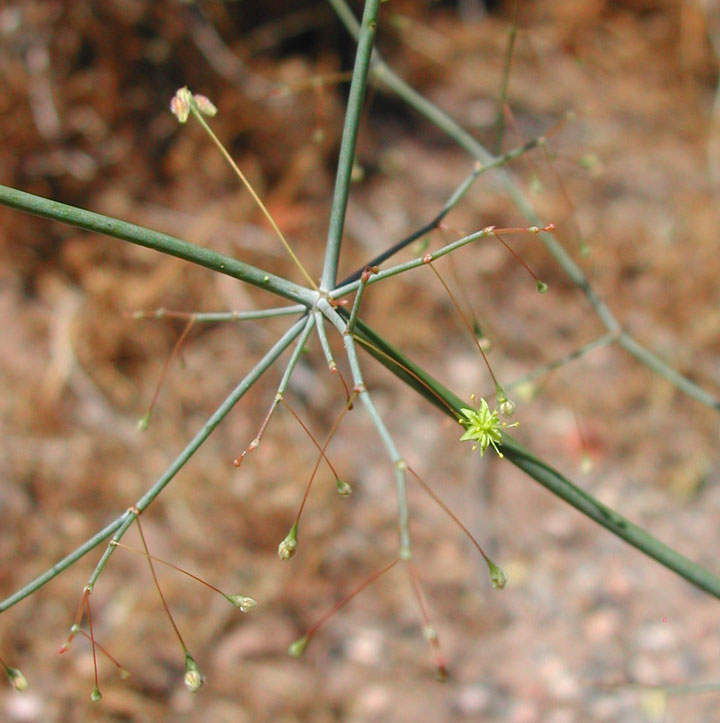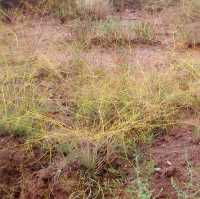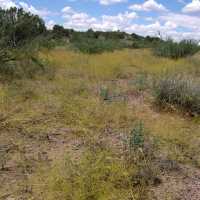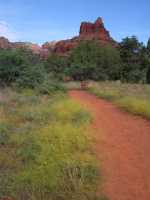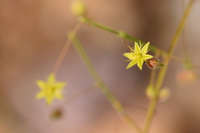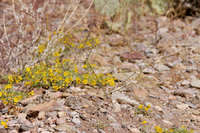Herbs, spreading to somewhat erect, annual, 1-4.5(-6) dm, glabrous and often glaucous, yellow-green. Stems: caudex absent; aerial flowering stems erect, occasionally hollow and fistulose, 0.5-2(-3) dm, glabrous, minutely hirsute or short-hispid proximally. Leaves basal; petiole 1-6 cm, hirsute; blade broadly oblong, (0.5-)1-2.5(-4) × (0.5-)1-2(-3) cm, short-hirsute on both surfaces and greenish, margins wavy. Inflorescences cymose, open to dense, usually spreading, 5-30 × 5-50 cm; branches usually not fistulose, glabrous; bracts 3, scalelike, 1-4 × 1-2 mm. Peduncles mostly erect, straight, capillary, 0.5-1.5 cm, glabrous. Involucres turbinate, 0.7-1 × 0.6-0.9 mm, glabrous; teeth 4(-5), erect, 0.3-0.4 mm. Flowers 1-2 mm; perianth yellow to greenish yellow with greenish to reddish midribs, densely hirsute with coarse curved hairs; tepals monomorphic, narrowly ovate; stamens exserted, 0.9-1.5 mm; filaments sparsely pubescent proximally. Achenes light brown to brown, lenticular to 3-gonous, 1-1.5 mm, glabrous.
Herbs, spreading to somewhat erect, annual, 1-4.5(-6) dm, glabrous and often glaucous, yellow-green. Stems: caudex absent; aerial flowering stems erect, occasionally hollow and fistulose, 0.5-2(-3) dm, glabrous, minutely hirsute or short-hispid proximally. Leaves basal; petiole 1-6 cm, hirsute; blade broadly oblong, (0.5-)1-2.5(-4) × (0.5-)1-2(-3) cm, short-hirsute on both surfaces and greenish, margins wavy. Inflorescences cymose, open to dense, usually spreading, 5-30 × 5-50 cm; branches usually not fistulose, glabrous; bracts 3, scalelike, 1-4 × 1-2 mm. Peduncles mostly erect, straight, capillary, 0.5-1.5 cm, glabrous. Involucres turbinate, 0.7-1 × 0.6-0.9 mm, glabrous; teeth 4(-5), erect, 0.3-0.4 mm. Flowers 1-2 mm; perianth yellow to greenish yellow with greenish to reddish midribs, densely hirsute with coarse curved hairs; tepals monomorphic, narrowly ovate; stamens exserted, 0.9-1.5 mm; filaments sparsely pubescent proximally. Achenes light brown to brown, lenticular to 3-gonous, 1-1.5 mm, glabrous.
Flowering year-round. Clayey, sandy to gravelly flats, washes, and slopes, mixed grassland, saltbush, creosote bush, blackbrush, and mesquite communities, pinyon and/or juniper woodlands; -60-1500(-1900) m; Ariz., Calif., Nev., N.Mex., Utah; Mexico (Baja California, Chihuahua, Sonora).
Flowering year-round. Clayey, sandy to gravelly flats, washes, and slopes, mixed grassland, saltbush, creosote bush, blackbrush, and mesquite communities, pinyon and/or juniper woodlands; -60-1500(-1900) m; Ariz., Calif., Nev., N.Mex., Utah; Mexico (Baja California, Chihuahua, Sonora).
Eriogonum trichopes is common on the Sonoran Desert and the southern portion of the Mojave Desert from southern California (Imperial, Inyo, Riverside, San Bernardino, and San Diego counties), eastward across southern Nevada (Clark, Lincoln, and Nye counties), southwestern Utah (Washington County), and Arizona (Coconino, Cochise, Gila, Graham, La Paz, Maricopa, Mohave, Pima, Pinal, Santa Cruz, Yavapai, and Yuma counties) to southern New Mexico (Cibola, Dona Ana, Grant, Hidalgo, Luna, Otero, and Valencia counties). It is also found to the south in northern Mexico (Baja California Norte, Sonora, and Chihuahua). Two related species occur in Baja California, the perennial E. scalare and the annual E. intricatum. Unlike E. trichopes, which occasionally has inflated stems, neither of those Mexican species exhibits that trait.
Eriogonum trichopes is common on the Sonoran Desert and the southern portion of the Mojave Desert from southern California (Imperial, Inyo, Riverside, San Bernardino, and San Diego counties), eastward across southern Nevada (Clark, Lincoln, and Nye counties), southwestern Utah (Washington County), and Arizona (Coconino, Cochise, Gila, Graham, La Paz, Maricopa, Mohave, Pima, Pinal, Santa Cruz, Yavapai, and Yuma counties) to southern New Mexico (Cibola, Dona Ana, Grant, Hidalgo, Luna, Otero, and Valencia counties). It is also found to the south in northern Mexico (Baja California Norte, Sonora, and Chihuahua). Two related species occur in Baja California, the perennial E. scalare and the annual E. intricatum. Unlike E. trichopes, which occasionally has inflated stems, neither of those Mexican species exhibits that trait.
Duration: Annual
Nativity: Native
Lifeform: Forb/Herb
General: Erect to spreading annual 10-45 cm tall, slender to nearly filiform branches, ultimate branches glabrous to sparsely glandular immediately above nodes, slightly glaucous, yellow-green.
Leaves: Basal, on petiole 1-6 cm, hirsute, blade broadly oblong 1-2.5 cm by 1-2 cm, short hirsute on both surfaces, greenish, with wavy margins.
Flowers: Cymose, open to dense, usually spreading, 5-30 cm by 5-50 cm, branches usually not cylindrical and hollow, but glabrous, 3 scalelike bracts, 1-4 mm by 1-2 mm, peduncles mostly erect, straight, capillary, 0.5-1.5 cm, glabrous; turbinate involucres, 0.7-1 mm by 0.6-0.9 mm, glabrous, teeth 4, erect, 0.3-0.4 mm; flowers 1-2 mm, perianth yellow to greenish yellow with greenish to reddish midribs, densely hirsute with coarse curved hairs; monomorphic tepals, narrowly ovate; exserted stamens, 0.9-1.5 mm, filaments sparsely pubescent proximally.
Fruits: Achenes light brown to brown, lenticular to three sided, 1-1.5 mm, glabrous.
Ecology: Found on sandy slopes and washes, even in clayey soils below 4,000 ft (1219 m); flowers January-December.
Distribution: CO and UT to AZ, CA and nw MEX
Notes: One of the more abundant of the Eriogonum in the low desert, often forming nearly pure stands.
Ethnobotany: Unknown, but other species in the genera have uses.
Etymology: Eriogonum is from Greek erion, wool and phyllon, leaf, while trichopes means hairy-footed or stalked.
Synonyms: None
Editor: SBuckley, 2010


